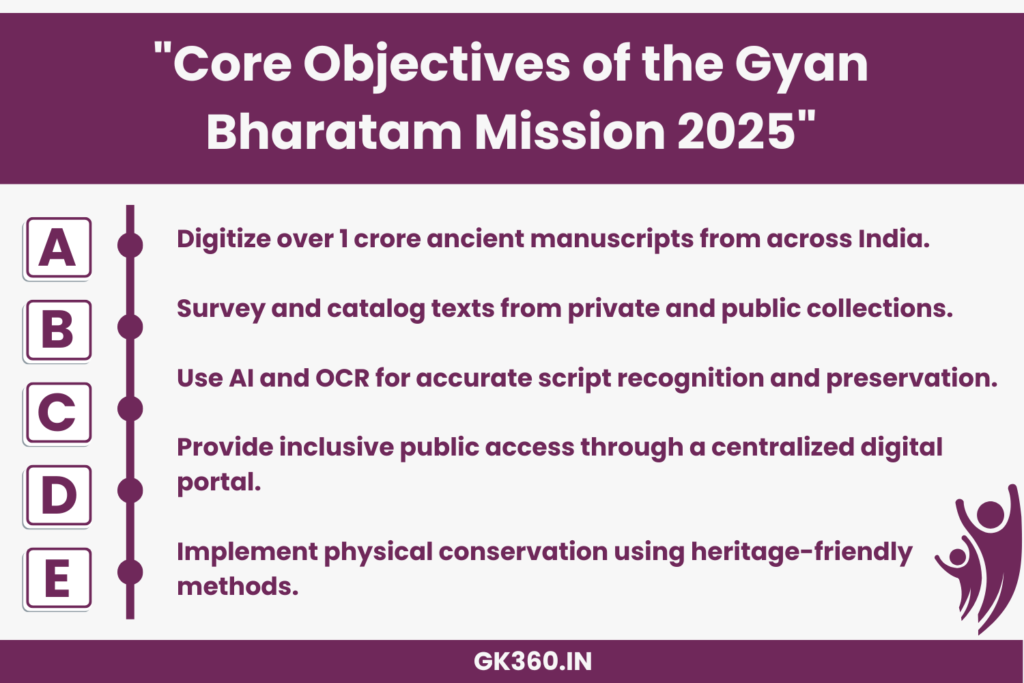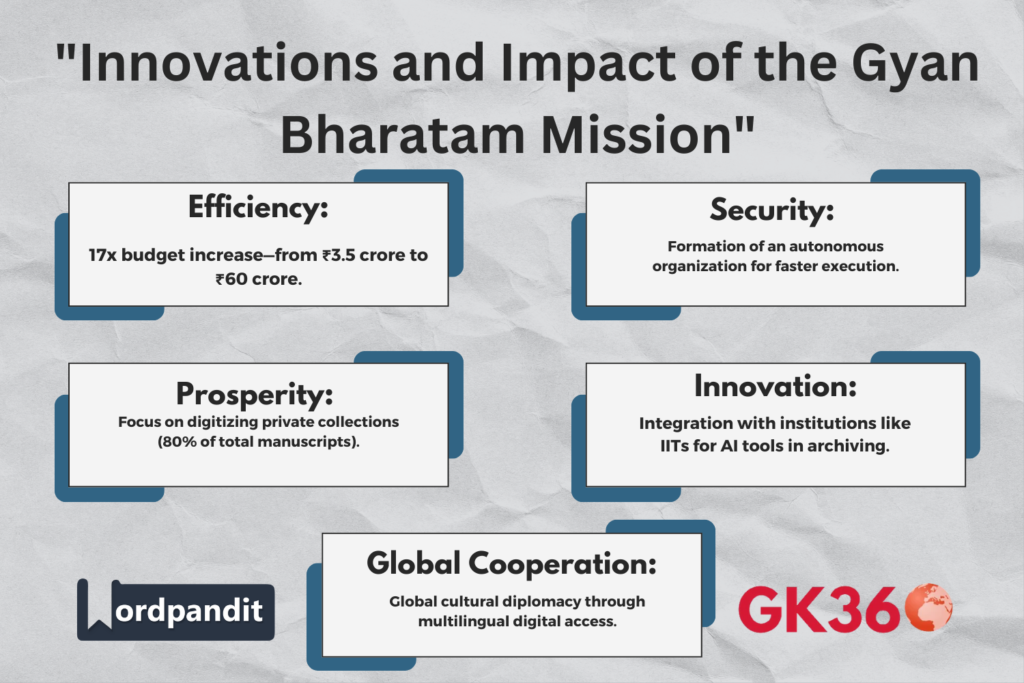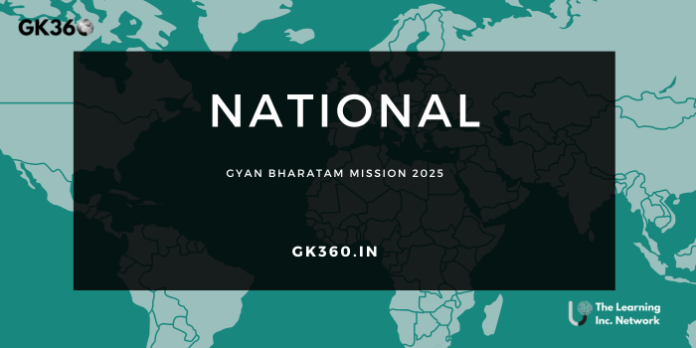Gyan Bharatam Mission 2025: PM Modi’s Vision to Digitize One Crore Ancient Manuscripts
Introduction
In a groundbreaking initiative aimed at cultural renaissance, Prime Minister Narendra Modi will relaunch the National Manuscripts Mission as the Gyan Bharatam Mission on June 9, 2025. This rejuvenated national effort seeks to digitize, document, and preserve over one crore ancient manuscripts, unlocking India’s vast intellectual heritage for scholars, students, and global audiences.
Backed by a dramatic increase in funding and an autonomous organizational structure, the Gyan Bharatam Mission stands at the crossroads of technology and tradition. With a renewed focus on private collections and public access, this mission is set to become a milestone in India’s journey to preserve its knowledge legacy and establish itself as a civilizational powerhouse in the digital age.

Table of Contents
- Introduction
- What is the Gyan Bharatam Mission?
- Why the Mission is in the News
- Core Objectives of the Mission
- Funding and Institutional Reform
- Key Features and Innovations
- Historical Background: National Manuscripts Mission
- Current Status and Achievements
- Expert Consultations and Strategy
- The Mission’s Broader Impact
- FAQs About Gyan Bharatam Mission
- Conclusion: India’s Wisdom in the Digital Era
What is the Gyan Bharatam Mission?
The Gyan Bharatam Mission is the revitalized avatar of the National Manuscripts Mission, originally launched in 2003. Now rebranded and upgraded, the mission aims to systematically identify, catalog, digitize, and conserve India’s manuscript wealth, encompassing rare texts in Sanskrit, Pali, Tamil, Persian, Prakrit, and other languages.
This initiative aspires to:
- Build a national database of over 1 crore manuscripts.
- Enable public access to digitized texts through modern platforms.
- Preserve physical manuscripts using scientific conservation techniques.
With PM Modi set to inaugurate the new phase, the mission highlights India’s renewed emphasis on protecting its civilizational wisdom and making it accessible in the digital age.
Why the Mission is in the News
The Gyan Bharatam Mission gained national attention following its prominent inclusion in the Union Budget 2025. A significant budgetary allocation and policy reforms signaled the government’s commitment to cultural preservation and knowledge dissemination.
Key Highlights:
- Launch Date: June 9, 2025
- Rebranding: National Manuscripts Mission renamed as Gyan Bharatam Mission
- Budget: Increased from ₹3.5 crore to ₹60 crore (17x growth)
- New Entity: A specialized organization is expected to be announced
This marks a paradigm shift from a bureaucratic project to a technologically driven, autonomous institution.
Core Objectives of the Mission
The Gyan Bharatam Mission’s objectives are comprehensive and focused on making India’s knowledge accessible and sustainable:
- Survey & Documentation: Identify manuscripts across universities, museums, temples, and private holdings.
- Digitization: Use digital platforms and OCR (Optical Character Recognition) to preserve ancient texts.
- Physical Conservation: Apply heritage-friendly scientific methods to protect fragile manuscripts.
- Inclusive Access Policy: Develop frameworks to allow scholars, students, and the public to access private collections.
- Institutional Autonomy: Create an efficient organizational structure for agile decision-making.
Funding and Institutional Reform
One of the mission’s transformative elements is its new funding model and governance structure:
- 17-Fold Budget Increase: The ₹60 crore budget enables scalable operations in digitization, conservation, and infrastructure.
- Autonomous Body Formation: A new independent organization will replace the existing framework under IGNCA, increasing transparency and execution speed.
- Focus on PPPs (Public-Private Partnerships): Encouraging collaboration with tech firms, academic bodies, and NGOs.
This infusion of resources and autonomy reflects a shift from preservation as obligation to preservation as national pride.
Key Features and Innovations
The Gyan Bharatam Mission introduces several pioneering features:
- Technology-Driven Archiving: Use of cloud databases, AI for script recognition, and multilingual tagging.
- Private Collection Outreach: Over 80% of manuscripts are privately held—this mission incentivizes their digitization and cataloging.
- Centralized Digital Library: An upcoming national portal to enable public access and multilingual search options.
- Academic Collaboration: Institutions like IITs and cultural centers will co-develop conservation and AI tools.
Historical Background: National Manuscripts Mission
The National Manuscripts Mission (NMM) was launched in 2003 under the Indira Gandhi National Centre for the Arts (IGNCA). It aimed to document and protect India’s vast collection of ancient manuscripts.
Key Challenges in the Original Mission:
- Limited Financial Resources: Only ₹3.5 crore allocated annually.
- Access Restrictions: Scholars faced red tape in accessing digitized content.
- Lack of Coordination: Scattered ownership between institutions and private collectors led to duplication and neglect.
Despite these hurdles, the mission did make progress, preparing metadata for 52 lakh manuscripts and digitizing around 3 lakh texts.
Current Status and Achievements
Over the past two decades, the National Manuscripts Mission has laid a foundational groundwork:
- 52 lakh manuscript entries catalogued.
- 3 lakh manuscripts digitized, but only 1.3 lakh uploaded publicly.
- Only 70,000 manuscripts are currently accessible.
- More than 9 crore folios preserved using scientific techniques.
Yet, the overwhelming percentage of manuscripts still remain locked away in private collections, out of reach for both scholars and the public.
Expert Consultations and Strategy
To shape a forward-looking vision, the mission underwent multi-disciplinary consultations with cultural scholars, technologists, and government officials.
Prominent Contributors:
- Udaya Narayana Singh – Linguist, Indian languages scholar.
- K. Ramasubramanian – Expert in ancient science and manuscripts.
- Sudha Gopalakrishnan – Specialist in digital archiving.
- Google Arts & Culture – Providing AI and digitization support.
The consultations focused on blending traditional archival knowledge with modern technologies, including AI, cloud computing, and multilingual metadata tagging.
The Mission’s Broader Impact
Beyond preservation, the Gyan Bharatam Mission is poised to transform India’s knowledge economy and cultural diplomacy.
1. Digital Access & Research
- Scholars will gain access to rare manuscripts, opening new areas of interdisciplinary research across history, linguistics, astronomy, and medicine.
2. Education & Curriculum Integration
- Ancient Indian knowledge—once digitized—can enrich school and university syllabi, promoting national pride and deeper learning.
3. Global Cultural Diplomacy
- Showcasing manuscripts via global digital platforms helps India project its role as a civilizational leader and a contributor to global knowledge.
4. Public Awareness & Cultural Revival
- Public exhibitions, workshops, and mobile apps can reignite public interest in manuscript heritage, especially among youth.

FAQs About Gyan Bharatam Mission
- What is the Gyan Bharatam Mission?
The Gyan Bharatam Mission is the rebranded and expanded version of the National Manuscripts Mission. It aims to digitize, conserve, and provide public access to over 1 crore ancient manuscripts from across India. - Why was the mission relaunched?
The relaunch addresses past inefficiencies by providing higher funding, modern technology, and autonomous governance to scale operations and improve accessibility. - What languages are included in the manuscript collection?
The collection spans Sanskrit, Tamil, Pali, Prakrit, Persian, Telugu, Bengali, Arabic, and more—covering philosophy, mathematics, medicine, law, and literature. - How will private manuscript holders be involved?
Private collectors—who hold over 80% of India’s manuscripts—will be offered incentives and digital tools to archive their manuscripts under national protection. - Where can I access the manuscripts?
A centralized digital manuscript portal is being developed to allow public browsing, download options, and researcher access across categories and languages.
Conclusion: India’s Wisdom in the Digital Era
The Gyan Bharatam Mission 2025 is not just a relaunch—it’s a renaissance. By harnessing digital power, expert collaboration, and public participation, India is poised to preserve its ancient knowledge for the future.
This mission represents a critical bridge between India’s glorious past and its technologically empowered future. With June 9 marking the beginning of this new chapter, scholars, students, and citizens alike are invited to celebrate, contribute, and explore this monumental cultural journey.
Key Takeaways Table
| Aspect | Details |
| Mission Relaunch Date | June 9, 2025 |
| Main Goal | Digitize, conserve, and make public over 1 crore ancient manuscripts |
| Funding | Increased 17-fold from ₹3.5 crore to ₹60 crore |
| New Structure | Autonomous body replacing IGNCA-led framework |
| Technological Integration | AI, OCR, cloud storage, multilingual tagging |
| Private Collection Focus | 80% manuscripts are privately held—now prioritized |
| Public Access | Centralized digital portal in development for global reach |





